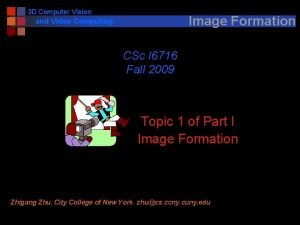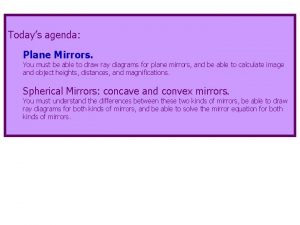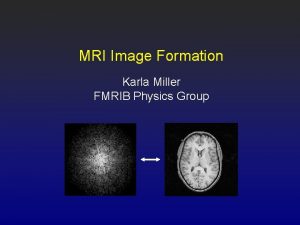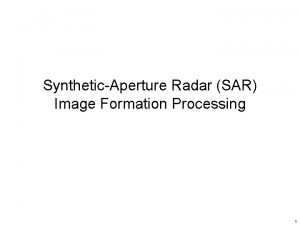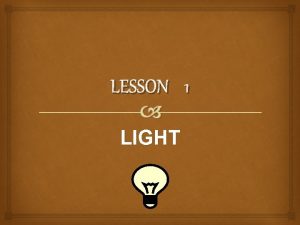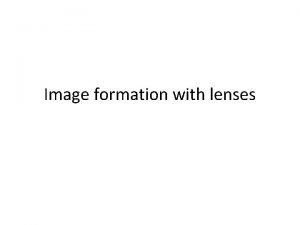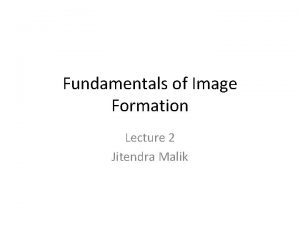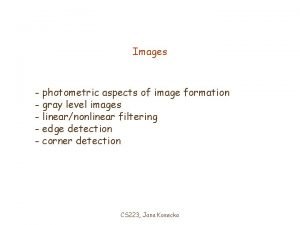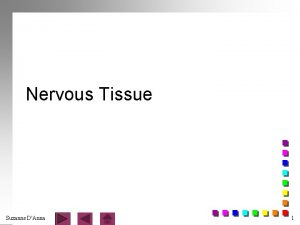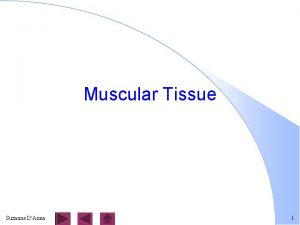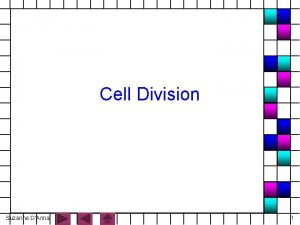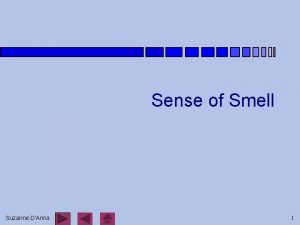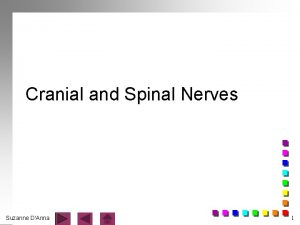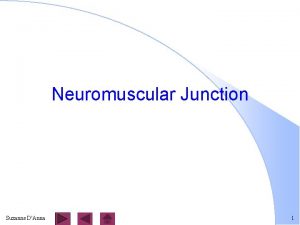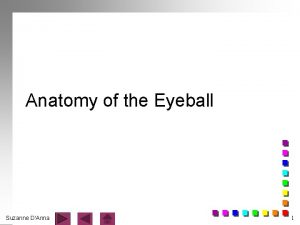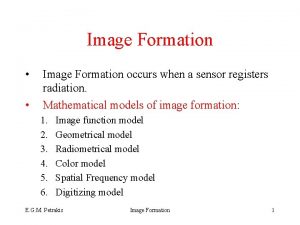Physiology of Vision Image Formation Suzanne DAnna 1





























- Slides: 29

Physiology of Vision Image Formation Suzanne D'Anna 1

Eye like a camera n cornea and lens focus an image of distant objects on retina “film” n contraction of ciliary muscles changes shape of lens to bring objects into focus n adjustment of pupil diameter helps maintain proper light exposure to retina n Suzanne D'Anna 2

Processes for Image Formation refraction of light rays by cornea and lens n accommodation of the lens n constriction of the pupil n accommodation and pupil size are controlled by smooth muscle fibers of ciliary muscle and iris (intrinsic eye muscles) Suzanne D'Anna 3

Refraction n the bending of light as it passes at an oblique angle from one medium (such as air) to another (such as water) Suzanne D'Anna 4

Refraction (cont. ) anterior and posterior surfaces of cornea refract light n both surfaces of lens further refract light into exact focus on retina n images are inverted (upside down) and reversed right to left n brain learns early in life to coordinate visual images with location of object Suzanne D'Anna 5

Refraction (cont. ) 3/4 of the focusing occurs on the cornea n lens is responsible for fine-tuning of image n convex surface of the lens causes light waves to converge (come to a point) n concave surface of lens causes light waves to diverge (fan out) n normal eye shape causes light waves to be sharply focused upon retina n Suzanne D'Anna 6

Light Refraction n light waves of distant objects travel at almost parallel angles - focused on retina by cornea and flatter lens n light waves of nearer objects reach eye in a more divergent line - the closer the object, the more divergent the lines Suzanne D'Anna 7

Accommodation n process by which the curvature or thickness of the lens is increased for near vision n divergent waves tend to focus behind the retina unless accommodation increases refracting power of the eye Suzanne D'Anna 8

Far Vision lens is fairly flat, held under tension by suspensory ligaments n light entering from distant objects strikes eye as parallel rays n refractory power of eye is sufficient to focus light rays on retina, producing sharp image n Suzanne D'Anna 9

Near Point minimum distance at which an object can be brought into clear focus n 4 inches in young adult n increasing distance at which an object can be brought into clear focus is primarily due to loss of elasticity and hardening of the lens, therefore its ability to accommodate - this condition is called presbyopia n Suzanne D'Anna 10

Emmetropic normal eye n can sufficiently refract rays from an object 6 feet away to focus a clear image on the retina n Suzanne D'Anna 11

Emmetropic focal point normal vision Suzanne D'Anna 12

Myopia nearsightedness n condition may result from too long an eyeball or a thickened lens n light waves’ point of focus is in front of the retina n concave lens corrects focus to a point further through the eyeball directly on the retina n Suzanne D'Anna 13

Myopia focal point myopia inability to see far objects Suzanne D'Anna 14

Hyperopia farsightedness n also known as hypermetropia n condition may result from too short a eyeball or a thin lens n light waves point of focus is behind the retina n convex lens corrects by focusing images directly on the retina n Suzanne D'Anna 15

Hyperopia focal point hyperopia inability to see near objects Suzanne D'Anna 16

Astigmatism irregularities or defects in curvature of the surface of lens or cornea n cornea is elliptical n some portions of an image are in focus on the retina while other portions are not and therefore image is blurred n Suzanne D'Anna 17

Visual Pathway begins in photoreceptors of retina - stimulated by image focused on retina n receptor potentials travel via optic nerve to lateral geniculate nucleus in thalamus then on to visual cortex on occipital lobe n processing of visual information occurs along entire pathway n Suzanne D'Anna 18

Photoreceptors rods - 20 million - stimulated by low intensity light n cones - 6 million - stimulated by high intensity light of color - three types of cones - named for different appearance of their outer segment - divided into outer and inner segment n Suzanne D'Anna 19

Photoreceptors layer of rods and cones Suzanne D'Anna 20

Rods cylindrical or rod-shaped n Outer segment contains: - many flattened saccules called lamallae arranged parallel to surface of retina - photosensitive pigment, rhodopsin, part of lamellar membrane transduction of light occurs in outer segment Suzanne D'Anna 21

Rods n (cont. ) Inner segment contains: - many mitochondria - cell nucleus - synaptic base which contains neurotransmitter glutamate Suzanne D'Anna 22

Rods (cont. ) predominant type of photoreceptors n found in all areas of retina except fovea centralis n extremely sensitive to light n in dim light rods are the only photoreceptor stimulated n do not distinguish color n all night images are black and white n image produced is not sharp 23 Suzanne D'Anna n

Cones tapered or cone-shaped Outer segment contains: - pigment-containing saccules n Inner segment contains: - many mitochondria - cell nucleus - large synaptic base which most likely contains neurotransmitter glutamate n Suzanne D'Anna 24

Cones (cont. ) fovea centralis contains a high concentration of cones n depression on fovea centralis increases exposure of cones to light waves (sharpest image) n Suzanne D'Anna 25

Cones (cont. ) n Photopigments: - blue-green - green-sensitive - red-sensitive Suzanne D'Anna 26

Color Blindness most forms result from the absence or deficiency of one of the three photopigments n inherited condition n most common type is red-green - deficiency of either red or green cones - red and green are seen as same color n Suzanne D'Anna 27

Red-Green Color Blindness gene for red-green color blindness is recessive, designated (c) n normal color vision, designated (C) dominant n C/c genes located on X chromosome n Y chromosome does not contain DNA that programs color vision n X chromosome dictates color blindness n Suzanne D'Anna 28

Red-Green Color Blindness (cont. ) only females who have two (Xc) genes are red-green color blind n in (XCXc) females trait is masked by the normal dominate (C) n males do not have the second (X) chromosome to mask the trait n all males with(Xc) will be red-green color blind n Suzanne D'Anna 29
 Image formation computer vision
Image formation computer vision Enron players
Enron players Danna nelson
Danna nelson Danna gianforte
Danna gianforte Danna creager
Danna creager Bolsa gutural
Bolsa gutural The range of values spanned by the gray scale is called:
The range of values spanned by the gray scale is called: Urinary system introduction
Urinary system introduction Physiology of vision
Physiology of vision Physiology of vision
Physiology of vision Physiology of vision
Physiology of vision Formation initiale vs formation continue
Formation initiale vs formation continue Human vision vs computer vision
Human vision vs computer vision This is most likely caused
This is most likely caused Paraxial
Paraxial Geometry of image formation
Geometry of image formation Latent image definition
Latent image definition Image formation mri
Image formation mri Image formation in camera
Image formation in camera Image formation
Image formation Factors influencing destination image
Factors influencing destination image Gurney mott theory
Gurney mott theory Geometric and photometric image formation
Geometric and photometric image formation Sar image formation
Sar image formation Image formation in sem
Image formation in sem Formation of image through narrow holes
Formation of image through narrow holes The principle involved in the image formation by lenses
The principle involved in the image formation by lenses Image formation outline
Image formation outline Fundamentals of image formation
Fundamentals of image formation Photometric image formation
Photometric image formation
